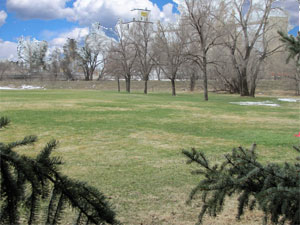- Overview
- Spotlight
- Photos
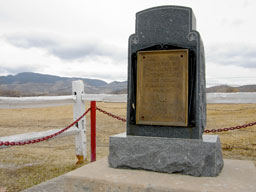
If you came to Laporte in 1865, you would probably have arrived in one of the four-horse Concord coaches that carried passengers between Denver, Colorado and Cheyenne, Wyoming each day. Stopping at the general store to post your letters and stretch your legs after the long coach ride, you would have noticed a town that was small, but busy. Around 100 people lived in log cabins along the Cache la Poudre River, and American Indian communities over-wintered in the Poudre Valley. Native and non-Native people in Laporte had created a community together, seen in the log cabins devoted to Baptist and Methodist church services and the community’s public and political meetings, and also in the branches in large cottonwood trees along the river where the bodies of the American Indian dead rested, wrapped in robes of animal skins.
Spanning both sides of the river, the area that became Laporte was traveled for centuries by American Indian peoples like the Utes, Comanches, Apaches, and Kiowa. By the mid-19th century the Arapaho, Cheyenne, and Lakota peoples were prominent in the area, with Pawnee, Crow, and Shoshone also traveling through. Laporte was permanently settled in 1859 by a group of French-Canadian fur trappers, many with American Indian wives. They surveyed and mapped plots of land along the river, built 50 houses, and named the settlement Colona. One year later, in 1860, the residents reorganized as the Laporte Townsite Company. The new town name – la porte – meant “the door” in French. As Colorado continued to grow, so did Laporte’s importance within the territory. In 1861 the town was chosen by the Colorado Territorial legislature as the seat for the newly established Larimer County, and in 1862 a stage stop was built in Laporte, bringing travelers on the Overland Trail through the town. That same year, the U.S. Army post of Camp Collins was established, although it would be relocated downstream to present-day Fort Collins after a devastating flood in 1864 destroyed the post.
The removal of the camp was the beginning of several changes for Laporte. In 1868, as the country’s railroad system continued to grow, the Overland Stage was discontinued. The loss of the stage line hurt Laporte, and in the early 1870s the title of Larimer County seat was given to the newly incorporated town of Fort Collins. The most striking changes came in the late 1870s when the town lost most of its original homesteaders. The forced removal of American Indians to Indian Territory (Oklahoma) and other reservations required the French-Canadian homesteaders to choose between staying with their land and leaving with their mixed-race families. All but one man chose to leave, and the families were relocated to the Red Cloud Agency in South Dakota. Today, with less than 3,000 persons listed as residents in the last census, Laporte is a quiet commuter community for its larger neighbor, Fort Collins.
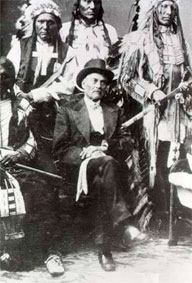
Joseph Antoine Janis, born in 1824 in St. Charles, Missouri, initially followed in his father’s footsteps as a fur trapper in the West, but eventually became a highly regarded interpreter, guide, and diplomat due to his knowledge of Native languages. Janis had traveled through the Poudre Valley in 1844, and he later reminisced in a letter to local historian Ansel Watrous that he found the “streams high” and “the valley black with buffalo.” He also noted that “the Poudre Valley was the ‘loveliest spot on earth’,” and “on the first of June 1844, [I] stuck my stake in a claim in the valley, intending the location selected for my home should the country ever be settled.” You can see Antoine Janis' original cabin in the Heritage Courtyard at the old Carnegie Library building in Library Park.
In the 1700s to mid-1800s the inter-marrying of European American trappers and traders to Indian women was common in the Western United States. As often was the case with traditional marrying between many Native groups, women were exchanged by the men in their families as part of an economic system. This was the case with First Elk Woman, wife to the first homesteader of Poudre Valley, Joseph Antoine Janis. Born in 1821 to the Oglala Lakota, First Elk Woman, also known as Mary Featherman, was given in exchange by her brother, Swift Bird, to Janis in 1846 at Fort Laramie, Wyoming.
Janis returned to the Poudre valley in 1859 with other French-Canadians and their Arapaho, Cheyenne, and Lakota wives. Janis and First Elk Woman spent almost 20 years in Laporte raising a large family of 14 to 16 children, farming their land, and operating a grocery and saloon. Janis was said to do occasional translation and diplomatic work. In the late 1870s, when state and federal policies forced Indians to relocate to reservations, the Janis family and most of their mixed-blood neighbors joined First Elk Woman’s uncle, Chief Red Cloud, at the Red Cloud Agency in South Dakota (now the Pine Ridge Reservation). Janis died in 1890 and First Elk Woman in the early 1900s (she was last noted in the Indian Census in 1905). Their numerous descendants can be found today living at Pine Ridge, other Indian reservations, and throughout the nation.
Laporte
- Facilities in Laporte
- Restaurant and gas station at Vern's Place, 4120 W County Road 54G
- Groceries available at Overland Foods, 3333 W County Road 54G
- Other nearby historical sites
- Cache la Poudre historical marker, County Road 50E (GPS coordinates 40°37’6"N 105°10’07"W)
- Bingham Hill Cemetery, County Road 50E (GPS coordinates 40°37’6"N 105°08’34"W)
- Historical cabin and DAR marker, County Road 21 (GPS coordinates 40°37’27"N 105°10’07"W)
Laporte, Colorado
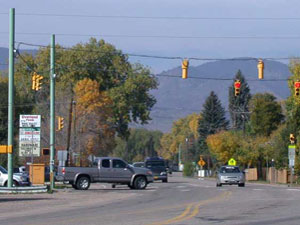
Fort Collins Museum of Discovery
- Location
- 200 Mathews Street, Fort Collins
- Hours
- Tues-Sat 10am-5pm, Sun 12-5pm
- Hours
- The Museum is closed at its 200 Mathews Street location. The new Fort Collins Museum of Discovery will open on November 11, 2012.
For more information, visit our website at fcmod.org
Other questions? Call us at 970-221-6738Old Carnegie Library Building
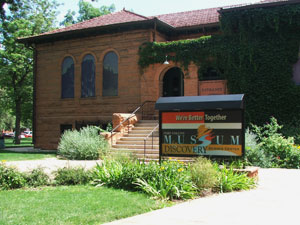
The Fort Collins Museum of Discovery was housed in the 1904 Carnegie Library Building
Old Town Fort Collins
- Parking
- Parking garages are located at the corner of Mason and Laporte, and on Mountain and Remington. For a parking map, click here
- Restaurants
- For a list of Old Town restaurants, click here
- Breweries
- For a list of Old Town breweries, click here
For more information, visit the Downtown Fort Collins website at www.downtownfortcollins.com
Historic Avery Building in Old Town Square
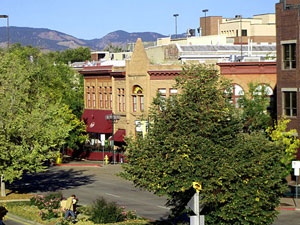
Photo from the City of Fort Collins website
Old Town Heritage Park
- Managing Agency
- City of Fort Collins Parks
- Location
- Old Fort Collins Heritage Park is located at the Northside Aztlan Center, 122 E. Willow Street
- Rules & Regulations
- Read the City of Fort Collins Parks Rules and Regulations here
- Activities & Facilities
- Old Town Heritage Park offers basketball courts, drinking fountains, playgrounds, racquetball courts, a skate park, and a turf area.
The Poudre River at Old Town Heritage Park
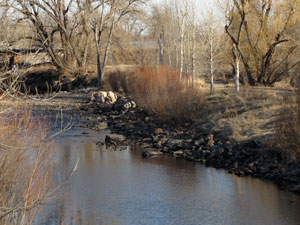
Gustav Swanson Natural Area
- Managing Agency
- City of Fort Collins Natural Areas Program
- Hours
- 5:00 am to 11:00 pm
- Directions
- Parking lot is on Linden Street, between Riverside and Buckingham.
When you visit, look for birds-over 45 species of birds have been seen here including green-winged teal, great blue herons, owls, kestrels, and Bullock’s orioles. Bats, foxes, and deer are also seen here from time to time. Visiting natural areas with a friend or in a group provides the best protection for personal safety.
Free educational programs at Gustav Swanson Natural Area are available for groups by request. Call the Master Naturalist Program at 970-416-2480.
Gustav Swanson Natural Area
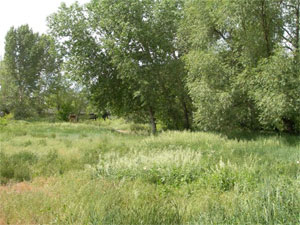
Photo courtesy of the City of Fort Collins Natural Areas Program
Buckingham Park
- Managing Agency
- City of Fort Collins Parks
- Location
- Buckingham Park is located at 101 First Street
- Rules & Regulations
- Read the City of Fort Collins Parks Rules and Regulations here
- Activities & Facilities
- Buckingham Park offers barbeque grills, baseball fields, basketball courts, drinking fountains, playgrounds, restrooms, picnic shelters, and a turf area.
Buckingham Park
